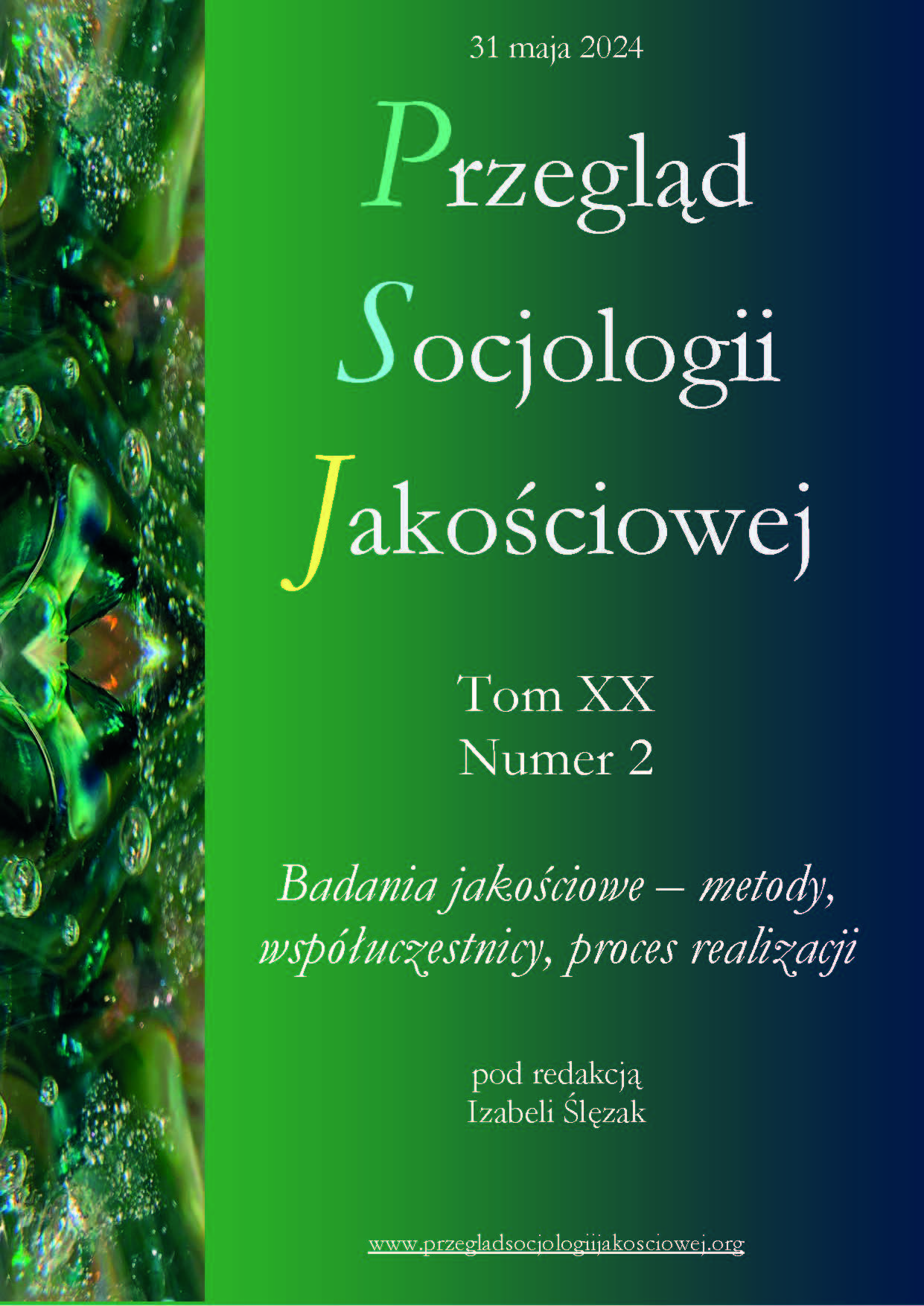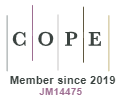Studying the Phantom Borderland: A Discussion of Techniques and Procedures
DOI:
https://doi.org/10.18778/1733-8069.20.2.05Keywords:
phantom border, mobile methods, collective memory, maps, borderscapingAbstract
In the paper, I undertake the problem of conducting research of the borderland of former Galicia and the Kingdom of Poland on the example of the project I carried out at the turn of 2021 and 2022. Because of the complexity of the problem, the procedure requires the integration of the borderland studies with approaches focused on the exploration of the relationship between the past and the present. It is necessary to reach the local and external actors; collect spatial, material, narrative, and embodied data; and recall values, attitudes, products, and practices.
In the text, I discuss the approach inspired by the multi-sited ethnography concept, including the mobility of the studied territory inhabitants and the involvement of the external structures of power. I indicate the ways in which this perspective can integrate different techniques: the analysis of maps and documents, observation, interviews, and goalongs to produce rich, mutually complementary data, allowing possibly the best understanding of the research topic.
Downloads
References
Anderson Jon (2004), Talking whilst walking: A geographical archaeology of knowledge, „Area”, vol. 36(3), s. 254–261, https://doi.org/10.1111/j.0004-0894.2004.00222.x
Google Scholar
DOI: https://doi.org/10.1111/j.0004-0894.2004.00222.x
Anderson Leon (2014), Autoetnografia analityczna, „Przegląd Socjologii Jakościowej”, t. X, nr 3, s. 144–167.
Google Scholar
DOI: https://doi.org/10.18778/1733-8069.10.3.07
Angrosino Michael (2010), Badania etnograficzne i obserwacyjne, Warszawa: Wydawnictwo Naukowe PWN.
Google Scholar
Banks Marcus (2013), Materiały wizualne w badaniach jakościowych, Warszawa: Wydawnictwo Naukowe PWN.
Google Scholar
Barth Fredrik (2006), Grupy i granice etniczne: społeczna organizacja różnic kulturowych, [w:] M. Kempny, E. Nowicka (red.), Badanie kultury. Elementy teorii antropologicznej. Kontynuacje, Warszawa: Wydawnictwo Naukowe PWN, s. 348–380.
Google Scholar
Bartkowski Jerzy (2003), Tradycja i polityka. Wpływ tradycji kulturowych polskich regionów na współczesne zachowania społeczne i polityczne, Warszawa: Wydawnictwo Akademickie Żak.
Google Scholar
Brambilla Chiara (2015), Exploring the Critical Potential of the Borderscapes Concept, „Geopolitics”, vol. 20(1), s. 14–34, https://doi.org/10.1080/14650045.2014.884561
Google Scholar
DOI: https://doi.org/10.1080/14650045.2014.884561
Brambilla Chiara, Laine Jussi, Scott James Wesley, Bocchi Gianluca (red.) (2015), Borderscaping: Imaginations and practices of border making, Burlington: Ashgate.
Google Scholar
DOI: https://doi.org/10.4324/9781315569765
Brunet-Jailly Emmanuel (2017), On the agency of borderlands, [w:] A. Grichting, M. Zebich-Knos (red.), The social ecology of border landscapes, London–New York: Anthem Press.
Google Scholar
DOI: https://doi.org/10.2307/j.ctt1pd2knr.7
Bukraba-Rylska Izabella (2007), A hundred years of village monographs in Poland. Jubilee reflections, „Polish Sociological Review”, vol. 160(4), s. 499–511.
Google Scholar
Charmaz Kathy (2009), Teoria ugruntowana. Praktyczny przewodnik po analizie jakościowej, Warszawa: Wydawnictwo Naukowe PWN.
Google Scholar
Clifford James (2006), Praktyki przestrzenne. Badania terenowe, podróże i praktyki dyscyplinujące w antropologii, [w:] M. Kempny, E. Nowicka (red.), Badanie kultury. Elementy teorii antropologicznej. Kontynuacje, Warszawa: Wydawnictwo Naukowe PWN, s. 139–179.
Google Scholar
Cohen Anthony P. (1985), The symbolic construction of community, London: Routledge.
Google Scholar
DOI: https://doi.org/10.4324/9780203323373
Crampton Jeremy W. (1996), Postmodernity and the territorial discourse of peace, „GeoJournal”, vol. 39(4), s. 353–361.
Google Scholar
DOI: https://doi.org/10.1007/BF02428498
Crampton Jeremy W. (2001), Maps as social constructions: power, communication and visualization, „Progress in Human Geography”, vol. 25(2), s. 235–252, https://doi.org/10.1191/030913201678580494
Google Scholar
DOI: https://doi.org/10.1191/030913201678580494
Czerny Andrzej (2015), Powstanie i etapy rozwoju map topograficznych do końca XIX wieku, [w:] A. Czerny (red.), Dawne mapy topograficzne w badaniach geograficzno-historycznych, Lublin: Uniwersytet Marii Curie-Skłodowskiej, s. 11–84.
Google Scholar
Ćwiek-Rogalska Karolina (2017), Zapamiętane w krajobrazie: krajobraz kulturowy czesko-niemieckiego pogranicza w czasach przemian, Warszawa: Wydawnictwo Naukowe Scholar.
Google Scholar
Denzin Norman K., Lincoln Yvonna S. (2009), Wprowadzenie. Dziedzina i praktyka badań jakościowych, [w:] N.K. Denzin, Y.S. Lincoln (red.), Metody badań jakościowych, t. 1, Warszawa: Wydawnictwo Naukowe PWN, s. 19–76.
Google Scholar
Dobrowolski Kazimierz (1967), Teoria podłoża historycznego, [w:] K. Dobrowolski (red.), Studia z pogranicza historii i socjologii, Wrocław: Wydawnictwo Polskiej Akademii Nauk, s. 6–51.
Google Scholar
Donnan Hastings, Wilson Thomas M. (2007), Granice tożsamości, narodu, państwa, Kraków: Wydawnictwo Uniwersytetu Jagiellońskiego.
Google Scholar
Evans James, Jones Phil (2011), The walking interview: Methodology, mobility and place, „Applied Geography”, vol. 31(2), s. 849–858, https://doi.org/10.1016/j.apgeog.2010.09.005
Google Scholar
DOI: https://doi.org/10.1016/j.apgeog.2010.09.005
Flick Uwe (2011), Jakość w badaniach jakościowych, Warszawa: Wydawnictwo Naukowe PWN.
Google Scholar
Gądecki Jacek (2011), Spacer jako forma doświadczenia przestrzeni codzienności, „Analecta Archaeologica Ressoviensia”, nr 6, s. 191–200.
Google Scholar
Gibbs Graham (2011), Analizowanie danych jakościowych, Warszawa: Wydawnictwo Naukowe PWN.
Google Scholar
Glaser Barney G. (2002), Constructivist Grounded Theory?, „Forum Qualitative Sozialforschung/Forum: Qualitative Social Research”, vol. 3(3), https://doi.org/10.17169/fqs-3.3.825
Google Scholar
Glaser Barney G., Strauss Anselm L. (2009), Odkrywanie teorii ugruntowanej. Strategie badania jakościowego, Kraków: Zakład Wydawniczy Nomos.
Google Scholar
Golka Marian (2009), Pamięć społeczna i jej implanty, Warszawa: Wydawnictwo Naukowe Scholar.
Google Scholar
Hammersley Martyn, Atkinson Paul (2001), Metody badań terenowych, Poznań: Wydawnictwo Zysk i S-ka.
Google Scholar
Harley John Brian (1989), Deconstructing the map, „Cartographica: The International Journal for Geographic Information and Geovisualization”, vol. 26(2), s. 1–20, https://doi.org/10.3138/E635-7827-1757-9T53
Google Scholar
DOI: https://doi.org/10.3138/E635-7827-1757-9T53
Hartshorne Richard (1933), Geographic and political boundaries in Upper Silesia, „Annals of the American Association of Geographers”, vol. 23(4), s. 195–228.
Google Scholar
DOI: https://doi.org/10.1080/00045603309357073
Haselsberger Beatrix (2014), Decoding borders. Appreciating border impacts on space and people, „Planning Theory & Practice”, vol. 15(4), s. 505–526, https://doi.org/10.1080/14649357.2014.963652
Google Scholar
DOI: https://doi.org/10.1080/14649357.2014.963652
Hirschhausen Béatrice von, Grandits Hannes, Kraft Claudia, Müller Dietmar, Serrier Thomas (2015), Phantomgrenzen: Räume und Akteure in der Zeit neu denken, Göttingen: Wallstein Verlag.
Google Scholar
Jones Phil, Evans James (2012), The spatial transcript: analysing mobilities through qualitative GIS, „Area”, vol. 44(1), s. 92–99, https://doi.org/10.1111/j.1475-4762.2011.01058.x
Google Scholar
DOI: https://doi.org/10.1111/j.1475-4762.2011.01058.x
Kacperczyk Anna (2014), Autoetnografia – technika, metoda, nowy paradygmat? O metodologicznym statusie autoetnografii, „Przegląd Socjologii Jakościowej”, t. X, nr 3, s. 32–75.
Google Scholar
DOI: https://doi.org/10.18778/1733-8069.10.3.03
Kacperczyk Anna (2016), Społeczne światy: teoria – empiria – metody badań. Na przykładzie społecznego świata wspinaczki, Łódź: Wydawnictwo Uniwersytetu Łódzkiego.
Google Scholar
DOI: https://doi.org/10.18778/7969-714-4
Knigge LaDona, Cope Meghan (2006), Grounded Visualization: Integrating the Analysis of Qualitative and Quantitative Data through Grounded Theory and Visualization, „Environment and Planning A: Economy and Space”, vol. 38(11), s. 2021–2037, https://doi.org/10.1068/a37327
Google Scholar
DOI: https://doi.org/10.1068/a37327
Kolb Bettina (2008), Involving, Sharing, Analysing – Potential of the Participatory Photo Interview, „Forum Qualitative Sozialforschung/Forum: Qualitative Social Research”, vol. 9(3), https://doi.org/10.17169/FQS-9.3.1155
Google Scholar
Konecki Krzysztof (2000), Studia z metodologii badań jakościowych. Teoria ugruntowana, Warszawa: Wydawnictwo Naukowe PWN.
Google Scholar
Konecki Krzysztof (2005), Wizualne wyobrażenia. Główne strategie badawcze w socjologii wizualnej a metodologia teorii ugruntowanej, „Przegląd Socjologii Jakościowej”, t. I, nr 1, s. 42–63.
Google Scholar
DOI: https://doi.org/10.18778/1733-8069.1.1.04
Krajewski Marek (2013), Są w życiu rzeczy... Szkice z socjologii przedmiotów, Warszawa: Fundacja Bęc Zmiana.
Google Scholar
Kula Marcin (2008), Co zbudować, co zburzyć? O świadectwach pamięci w Polsce w 2007 r., „Przegląd Historyczny”, nr 99(1), s. 105–116.
Google Scholar
Kurcz Zbigniew (2008), Przedmiot socjologii pogranicza w świetle polskich doświadczeń, [w:] Z. Kurcz (red.), Polskie pogranicza w procesie przemian, Wałbrzych: Wałbrzyska Wyższa Szkoła Zarządzania i Przedsiębiorczości, s. 19–28.
Google Scholar
Kurczewska Joanna (2015), Kreacje małych ojczyzn, „Societas/Communitas”, nr 19–20(1–2), s. 39–64.
Google Scholar
Kusenbach Margarethe (2003), Street Phenomenology: The Go-Along as Ethnographic Research Tool, „Ethnography”, vol. 4(3), s. 455–485, https://doi.org/10.1177/146613810343007
Google Scholar
DOI: https://doi.org/10.1177/146613810343007
Kvale Steinar (2012), Prowadzenie wywiadów, Warszawa: Wydawnictwo Naukowe PWN.
Google Scholar
Kwilecki Andrzej (1988), Tradycje socjologii polskiej, „Ruch Prawniczy, Ekonomiczny i Socjologiczny”, nr 50(2), s. 237–262.
Google Scholar
Lefebvre Henri (1991), The production of space, Oxford–Cambridge: Blackwell.
Google Scholar
Lisiecki Stanisław (2009), O granicach naturalnych, politycznych, społecznych i… granicach w głowie: szkice do socjologii pogranicza polsko-niemieckiego, Poznań: Wydawnictwo Uniwersytetu Adama Mickiewicza.
Google Scholar
Löwis Sabine von (2015), Phantom borders in the political geography of East Central Europe: An introduction, „Erdkunde”, vol. 69(2), s. 99–106, https://doi.org/10.3112/erdkunde.2015.02.01
Google Scholar
DOI: https://doi.org/10.3112/erdkunde.2015.02.01
Łukasiuk Magdalena (2011), Socjologia architektury w badaniach krajobrazu kulturowego miasta, „Przegląd Socjologiczny”, nr 60(2–3), s. 93–110.
Google Scholar
Macdonald Sharon (2013), Memorylands: Heritage and identity in Europe today, London: Routledge.
Google Scholar
DOI: https://doi.org/10.4324/9780203553336
Malicki Krzysztof (2016), 70 lat po Zagładzie: przeszłość Żydów w pamięci zbiorowej mieszkańców Rzeszowa, Rzeszów: Wydawnictwo Uniwersytetu Rzeszowskiego.
Google Scholar
Marcus George E. (1995), Ethnography in/of the world system: The emergence of multi-sited ethnography, „Annual Review of Anthropology”, vol. 24, s. 95–117.
Google Scholar
DOI: https://doi.org/10.1146/annurev.anthro.24.1.95
Martini Natalia (2020), Using GPS and GIS to Enrich the Walk-along Method, „Field Methods”, vol. 32(2), s. 180–192, https://doi.org/10.1177/1525822X20905257
Google Scholar
DOI: https://doi.org/10.1177/1525822X20905257
Nowak Jacek (2011), Społeczne reguły pamiętania: antropologia pamięci zbiorowej, Kraków: Wydawnictwo Uniwersytetu Jagiellońskiego.
Google Scholar
Nóżka Marcjanna, Martini Natalia (2015), Metody mobilne i wizualne w praktyce badawczej. Zastosowanie fotospaceru w socjologicznych badaniach map mentalnych i zachowań terytorialnych ludzi, „Przegląd Socjologii Jakościowej”, t. XI, nr 4, s. 34–50.
Google Scholar
DOI: https://doi.org/10.18778/1733-8069.11.4.02
Ossowski Stanisław (1984), O ojczyźnie i narodzie, Warszawa: Państwowe Wydawnictwo Naukowe.
Google Scholar
Pink Sarah (2007), Walking with video, „Visual Studies”, vol. 22(3), s. 240–252, https://doi.org/10.1080/14725860701657142
Google Scholar
DOI: https://doi.org/10.1080/14725860701657142
Pokojska Justyna (2017), Granice na pograniczu? Przypadek pogranicza polsko-słowackiego Sromowce Niżne – Czerwony Klasztor, Warszawa: Wydawnictwo Naukowe Scholar.
Google Scholar
Porczyński Dominik, Wojakowski Dariusz (2020), Borderlands from the resilience perspective: Diversification of state borders in former Austrian Galicia, „Regional Science Policy & Practice”, vol. 12(5), s. 793–813, https://doi.org/10.1111/rsp3.12306
Google Scholar
DOI: https://doi.org/10.1111/rsp3.12306
Sacha Magdalena Izabella (2014), Z biegiem Piaśnicy. Miejsca pamięci wokół „granicy fantomowej” na Północnych Kaszubach, „Przegląd Zachodni”, nr 352(3), s. 169–183.
Google Scholar
Sadowski Andrzej (2008), Pogranicze – Pograniczność – Tożsamość pogranicza, „Pogranicze. Studia Społeczne”, nr 14, s. 17–30.
Google Scholar
Sadowski Andrzej (2019), Społeczeństwo wielokulturowe z perspektywy pogranicza, Kraków: Zakład Wydawniczy Nomos.
Google Scholar
DOI: https://doi.org/10.24425/nauka.2019.129243
Sadowski Andrzej, Czerniawska Mirosława (1999), Tożsamość Polaków na pograniczach, Białystok: Wydawnictwo Uniwersytetu w Białymstoku.
Google Scholar
Siemaszko Jerzy (2018), Ewolucja i rozwój metody AZP z punktu widzenia praktyka, „Kurier Konserwatorski”, nr 15, s. 7–14.
Google Scholar
Silverman David (2008), Prowadzenie badań jakościowych, Warszawa: Wydawnictwo Naukowe PWN.
Google Scholar
Słomka Jan (2021), Pamiętniki włościanina: od pańszczyzny do dni dzisiejszych, Tarnów: Studio Książki.
Google Scholar
Sobczyński Marek (1993), Trwałość dawnych granic państwowych w krajobrazie kulturowym Polski, t. 14, Warszawa: Wydawnictwa Instytutu Geografii i Przestrzennego Zagospodarowania PAN.
Google Scholar
Szlachcicowa Irena (2019), Borderscapes – krajobrazy granic jako nowa perspektywa badań, „Politeja”, nr 58(1), s. 15–29, https://doi.org/10.12797/Politeja.16.2019.58.02
Google Scholar
DOI: https://doi.org/10.12797/Politeja.16.2019.58.02
Szpociński Andrzej (2014), Nośniki pamięci, miejsca pamięci, „Sensus Historiae”, nr 17(4), s. 17–26.
Google Scholar
Šimon Martin (2015), Measuring phantom borders: the case of Czech/Czechoslovakian electoral geography, „Erdkunde”, vol. 69(2), s. 139–150, https://doi.org/10.3112/erdkunde.2015.02.04
Google Scholar
DOI: https://doi.org/10.3112/erdkunde.2015.02.04
Titles and Abstracts of Papers: St. Louis, 1935 (1936), „Annals of the Association of American Geographers”, vol. 26(1), s. 38–89, https://doi.org/10.1080/00045603609357147
Google Scholar
DOI: https://doi.org/10.1080/00045603609357147
Traba Robert (2017), Krajobraz kulturowy: strategie badawcze i interpretacje. Uwagi wstępne, [w:] R. Traba, V. Julkowska, T. Stryjakiewicz, Krajobrazy kulturowe, Warszawa: Wydawnictwo Neriton, s. 11–24.
Google Scholar
Wiśniewski Rafał, Pol Grażyna (2021), Acting for the Local Community: Hybrid Ethnography in the Careers of Local Culture Animators, „Przegląd Socjologii Jakościowej”, t. XVII, nr 3, s. 164–183, https://doi.org/10.18778/1733-8069.17.3.09
Google Scholar
DOI: https://doi.org/10.18778/1733-8069.17.3.09
Włodarek Mateusz (2021), Studia socjologiczne nad architekturą. W stronę architektury jako procesu (re)konstruowania, „Kultura i Społeczeństwo”, nr 65(3), s. 107–124, https://doi.org/10.35757/KiS.2021.65.3.6
Google Scholar
DOI: https://doi.org/10.35757/KiS.2021.65.3.6
Wojakowski Dariusz (2002a), O technice malowania obrazów, czyli teoretyczne dylematy socjologii pogranicza, „Przegląd Polonijny”, nr 29(3), s. 39–56.
Google Scholar
Wojakowski Dariusz (2002b), Polacy i Ukraińcy. Rzecz o pluralizmie i tożsamości na pograniczu, Kraków: Zakład Wydawniczy Nomos.
Google Scholar
Wojakowski Dariusz (2007), Swojskość i obcość w zmieniającej się Polsce, Warszawa: Wydawnictwo Instytutu Filozofii i Socjologii PAN.
Google Scholar
Wojakowski Dariusz (2013), Kłopoty z pograniczem. Socjologia wobec tradycji i ponowoczesności, „Zeszyty Naukowe Politechniki Śląskiej”, nr 65, s. 419–431.
Google Scholar
Zarycki Tomasz (2015), The electoral geography of Poland: between stable spatial structures and their changing interpretations, „Erdkunde”, vol. 69(2), s. 107–124, https://doi.org/10.3112/erdkunde.2015.02.02
Google Scholar
DOI: https://doi.org/10.3112/erdkunde.2015.02.02
Downloads
Published
Versions
- 2024-07-10 (2)
- 2024-05-31 (1)
How to Cite
Issue
Section
License

This work is licensed under a Creative Commons Attribution-NonCommercial-NoDerivatives 4.0 International License.














